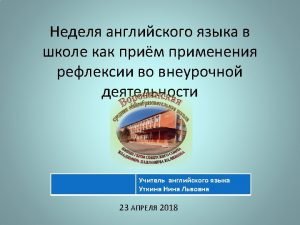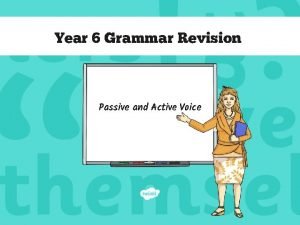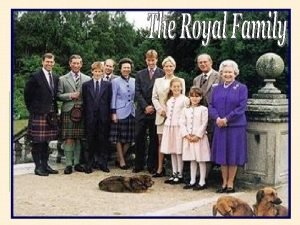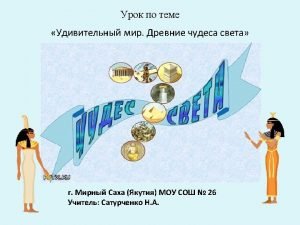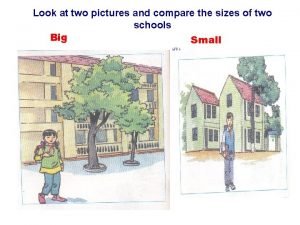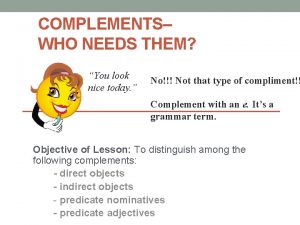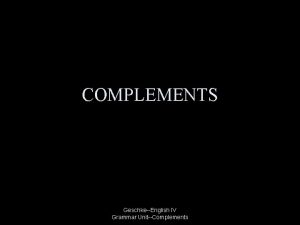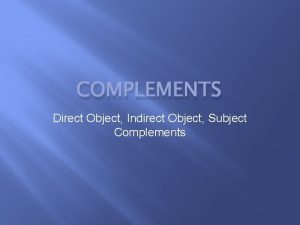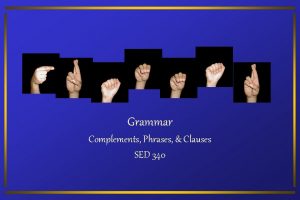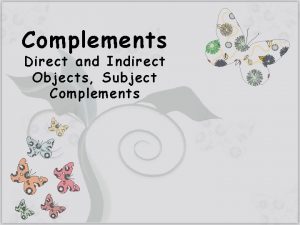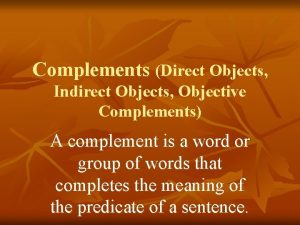Complements who needs them You look nice today





















- Slides: 21

Complements– who needs them? “You look nice today. ” No!!! Not that type of compliment!! Complement with an e. It’s a grammar term. Unit EQ: How do I distinguish among the following complements: - direct objects - indirect objects - predicate nominatives - predicate adjectives?

Complements: Direct and Indirect Objects Lesson EQ: How does a noun, pronoun, or word group function as a(n) direct and indirect object?

Activator Brain. Pop! “Verbs and Their Objects”

What is a Complement? • A complement is a word or word group that completes the meaning of a verb. • There are four main types of complements: 1. Direct Objects 2. Indirect Objects 3. Predicate Nominatives 4. Predicate Adjectives

1. Direct Objects • A direct object is a noun, pronoun, or word group that tells who or what receives the action.

Direct Objects In order to find the direct object, There are 2 questions you must ask: #1: Does the sentence have an action verb? - The sentence MUST have an action verb in order to have a direct object. #2: Who or what receives the action of the verb? - This answer will give you the direct object.

Direct Objects Example: Mrs. Mains dunked the basketball. #1: What is the action verb? The word “dunked” is the action verb. #2: Who or what is being “dunked”? The basketball is being dunked. Therefore, “basketball” is the direct object. Mrs. Mains dunked the basketball.

Direct Objects Let’s practice: I met Mr. Mason. First, ask: What is the action verb? met Second, ask: Who or what was “met”? Mr. Mason; Mr. Mason is the direct object. I met Mr. Mason.

Direct Objects Notice: A direct object is NEVER in a preposition phrase. 1. She worked with clay. Clay is not the direct object. It is the object of the preposition with. 2. She worked the clay with her hands. Clay is the direct object. Hands is the object of the preposition with.

Assessment Prompt Underline the verb(s)/verb phrase(s) and put “DO” over the direct object(s). 1. 2. 3. 4. 5. Did Bill hit a home run? Please buy fruit, bread, and milk. My uncle repairs engines and sells them. She ate with her friends. We bought ribbon, wrapping paper and tape.

Direct Objects 1. 2. 3. 4. 5. Underline the verb(s)/verb phrase(s) and put “DO” over the direct object(s). Did Bill hit a home run? Please buy fruit, bread, and milk. My uncle repairs engines and sells them. She ate with her friends. We bought ribbon, wrapping paper, and tape.

2. Indirect Objects • An indirect object is a noun, pronoun, or word group that appears in sentence telling to whom, to what, for whom or for what the action of the verb is done.

Indirect Objects In order to find the indirect object, There are 2 questions you must ask: #1: Does the sentence have a direct object? - The sentence MUST have a direct object in order to have an indirect object. #2: To whom, to what, for whom, or for what was the action done? - This answer will give you the indirect object.

Indirect Objects Example: I kicked Sally the soccer ball. First, determine if the sentence has a direct object? #1: Is there an action verb? Yes, the word “kicked” is the action verb. #2: Who or what is “kicked”? The soccer ball was kicked. Therefore, “soccer ball” is the direct object. I kicked Sally the soccer ball.

Indirect Objects If there is a direct object then ask To whom, to what, for whom, or for what was the action done? I kicked Sally the soccer ball. #3: To whom was the soccer ball kicked? The soccer ball was kicked to Sally. Therefore, “Sally” is the indirect object. I kicked Sally the soccer ball.

Indirect Objects Let’s practice: The waiter gave her the bill. First, ask What is the action verb? gave Second, ask What is the direct object? Gave what? bill Third, ask To what, to whom, for what, or for whom was the action being done? Gave bill to? her; her is the indirect object. The waiter gave her the bill.

Indirect Objects Notice: An indirect object is NEVER in a preposition phrase. 1. The ship’s captain gave orders to the crew. Crew is not the indirect object. It is the object of the preposition to. 2. The ship’s captain gave the crew orders. Crew is the indirect object.

Indirect Objects Underline the verb(s)/verb phrase(s) and put “DO” over the direct object(s) and “IO” over the indirect objects. 1. 2. 3. 4. 5. Pam left the waiter a tip. Did she tip him five dollars? The ship’s captain gave the crew orders. Glover made us some lasagna. Felicia threw David, Jane, and Paula slow curveballs.

Indirect Objects Underline the verb(s)/verb phrase(s) and put “DO” over the direct object(s) and “IO” over the indirect objects. 1. 2. 3. 4. 5. Pam left the waiter a tip. Did she tip him five dollars? The ship’s captain gave the crew orders. Glover made us some lasagna. Felicia threw David, Jane, and Paula slow curveballs.

Dear Absent Student: Dear Absent Student, Today we learned about Direct and Indirect Objects. In order to find the direct and indirect objects of a sentence you: (list the 4 questions in your own words). It’s so easy, just look at this example sentence: (Give your own example sentence and find the direct and indirect objects). If you are having trouble Gum Workbook Page 70, 71, 72, and 73 should help! Sincerely,

Workbook • GUM Workbook Pages: – 70 ALL – 71 ALL – 72 ALL – 73 ALL
 You look nice today
You look nice today Look up look down look left look right
Look up look down look left look right If you can t beat them join them
If you can t beat them join them Hello everybody look at this nice picture
Hello everybody look at this nice picture Oh look it is going to snow soon
Oh look it is going to snow soon Primary needs and secondary needs
Primary needs and secondary needs Primary needs and secondary needs
Primary needs and secondary needs Primary needs and secondary needs
Primary needs and secondary needs Strategic gender needs and practical gender needs
Strategic gender needs and practical gender needs What is target needs
What is target needs Today meeting or today's meeting
Today meeting or today's meeting In todays lesson
In todays lesson Today meeting or today's meeting
Today meeting or today's meeting Fingerprint ridge characteristics worksheet
Fingerprint ridge characteristics worksheet Today's lesson or today lesson
Today's lesson or today lesson Today's lesson or today lesson
Today's lesson or today lesson How you use ict today and how you will use it tomorrow
How you use ict today and how you will use it tomorrow Active vs passive revision
Active vs passive revision 21 february 1952 picture
21 february 1952 picture Look at the photos and match them with the words in the box
Look at the photos and match them with the words in the box Look at the pictures and match
Look at the pictures and match Look at the two pictures and compare them
Look at the two pictures and compare them


